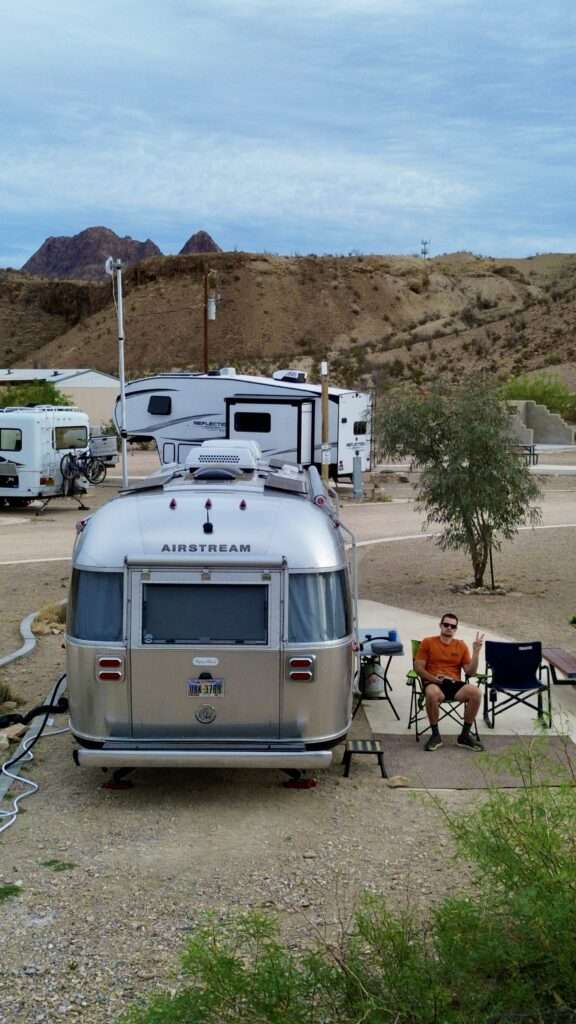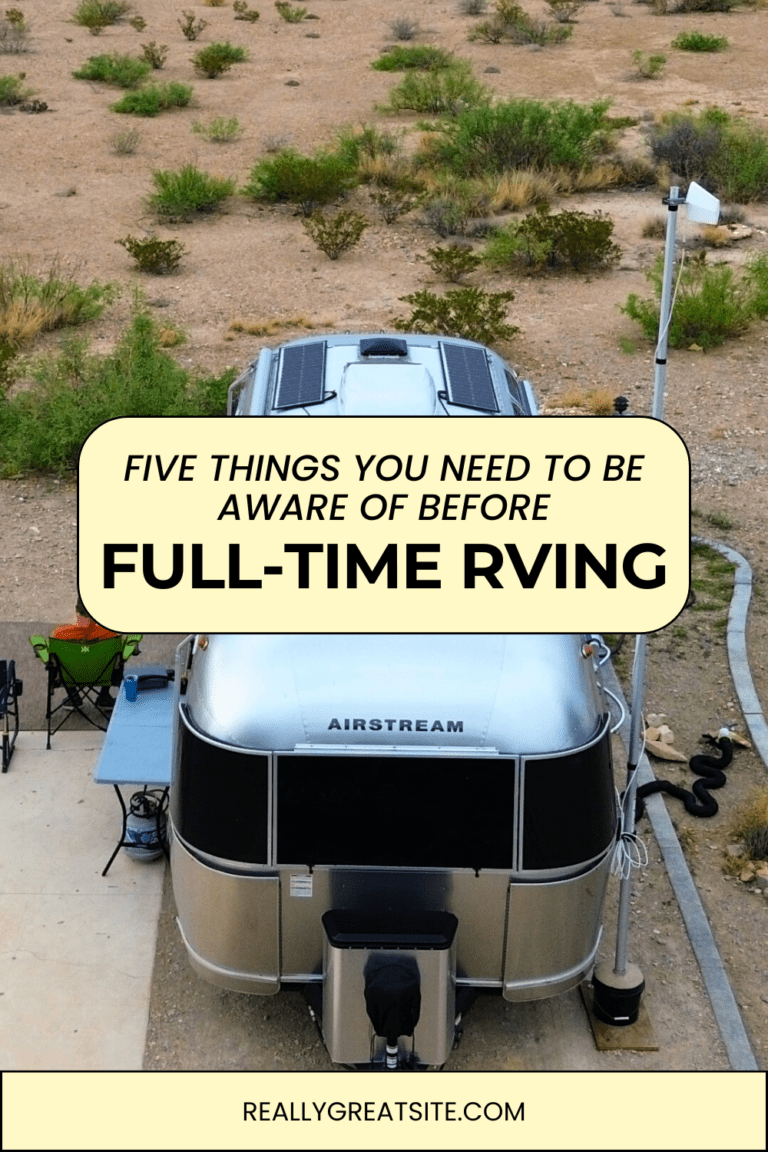After 18 months of full-time RVing —traveling intensely across the U.S. and chasing as many bucket list destinations as possible—we’ve decided it’s time to pause and find a home base again. This lifestyle gave us so many incredible experiences, but it also came with challenges we didn’t fully anticipate.
If you’re considering full-time RVing, or you’re just curious about what it really looks like behind the scenes, here are five things we genuinely wish we had known before we started.
1. It’s More Expensive Than People Make It Out to Be

There’s a common myth that full-time RVing is a cheap way to live and travel. While it’s possible to make it affordable—especially if you’re boondocking often and staying put for longer stretches—it’s not nearly as budget-friendly as social media and YouTube often make it seem.
Campground fees alone can range from $30 to $70+ per night, and those costs add up fast. Fuel is another major expense, especially if you’re towing a travel trailer or driving a large rig. Then there’s ongoing maintenance, RV upgrades, and the unexpected—like flat tires or emergency repairs. Add in recurring monthly costs like health insurance, phone service, and possibly a storage unit, and your budget can stretch further than expected.
Since we were both working full-time while traveling, we relied heavily on established campgrounds. We needed access to unlimited power, water hookups, laundry, reliable cell service, and proximity to town for groceries and errands. While those amenities made daily life easier, they came at a premium. On top of that, we were moving to new destinations almost every week—which increased our fuel expenses and limited our ability to take advantage of discounted rates.
If you want to stretch your budget further, consider slowing down. Many campgrounds offer significant monthly discounts, so staying in one place for a few weeks at a time can dramatically lower your overall cost.
What we weren’t prepared for was how much money we’d end up spending on our truck. We towed a travel trailer and learned quickly that choosing the right tow vehicle is crucial. If you’re considering a diesel truck, know that they operate very differently from regular gas vehicles—both in terms of maintenance needs and cost. Repairs WILL cost thousands and oil changes are over 200 dollars. Do your research beforehand, especially when it comes to towing capacity, repair costs, and fuel efficiency. A poorly chosen tow vehicle can become a major stressor—and a financial burden. It is better to have too much tow capacity than too little, especially if you plan to travel out west and drive through some mountains.
Pro tip: Build a realistic budget and track your expenses the first few months. Expect the unexpected.
2. Invest in a Solid Boondocking Setup

If we could go back, we’d prioritize our boondocking setup from day one. Campgrounds fill up fast, especially during peak season, and having the flexibility to stay off-grid opens up so many more options—not to mention it can save you money. We often had to stay well over an hour away from National Parks due to the prices of campgrounds.
One of the biggest advantages of a solid boondocking setup is the ability to camp for free on Bureau of Land Management (BLM) land, often just a short drive from National Parks. With the right equipment, you can park in stunning locations, enjoy more space, and stay much closer to the parks without having to deal with crowded campgrounds or paying for sites.
We initially thought we could get by with basic solar power and water storage, but what we didn’t account for was the amount of power we’d need—especially during the summer months when we were craving the comfort of air conditioning. If we had invested in a generator earlier, we could’ve boondocked for much longer periods without worrying about running out of power or having to seek out a nearby campground.
A good generator would have allowed us to run our air conditioners, recharge our batteries on cloudy days, and stay off-grid for extended periods without relying on crowded campgrounds or limited resources. While solar power is fantastic for basic needs, we quickly realized that a solid generator would’ve been essential for staying comfortable in extreme weather or for longer stays in remote areas.
A quality solar setup, large-capacity batteries, a good inverter, and extra water storage can help you stay off-grid for a week or more comfortably. But pairing that with a reliable generator for backup power is a game-changer, especially if you’re traveling through hotter climates or need more consistent energy to keep things running smoothly.
Pro tip: Don’t forget to factor in the need for leveling blocks, many campers have auto leveling, but ours did not.
3. Starlink Is Worth Every Penny
We went most of the year without Starlink, thinking we could get by with just our cell boosters and hotspot plans. While those tools helped us stay connected in some areas, they were far from reliable in remote places—especially if we were camped out in the middle of nowhere.
We didn’t make the leap to Starlink until July 2024, and looking back, we wish we’d done it much sooner. Whether you’re working remotely, uploading content, or just want the ability to stream a movie after a long day of hiking, Starlink has been an absolute game-changer for us.
While Starlink isn’t perfect everywhere (and signal strength can still vary depending on location), the peace of mind knowing that we’ll likely have a strong enough connection—even in the most remote spots—has been worth every penny. It’s especially handy when you’re in a national park or a BLM area far from any town or campground with reliable Wi-Fi.
For anyone considering full-time RVing or long-term travel, if you rely on the internet for work, content creation, or even just staying in touch with loved ones, Starlink is an investment you won’t regret. It’s not a perfect solution everywhere, but it’s a huge step forward from traditional hotspots and cellular boosters.
4. Full-Time Rving Is Incredibly Time Consuming
RV life is often romanticized as laid-back and slow-paced, but in reality, it’s a lot of work. Between route planning, booking campgrounds, dumping tanks, doing laundry, handling breakdowns, and managing weather shifts, it can easily take over your days if you’re not prepared.

One of the biggest surprises for us was how much time it takes just to set up and tear down camp on travel days. Unlike driving a car, traveling with a trailer or RV involves a lot more time spent hitching, leveling, connecting utilities, and ensuring everything is in place. Add in the extra time for driving (which is often slower than in a regular vehicle), and we found ourselves dedicating most of the day just to the logistics of moving from one place to another.
Even with content creation or remote work added into the mix, travel days were never as easy or quick as we imagined. This meant that our schedule was often packed, and downtime felt scarce.
Looking back, we realized that RV life is fantastic for those who have the time to dedicate to it—like retirees or people looking for a slower, more intentional pace of travel. It’s not a lifestyle that works well for those trying to cram everything into a short vacation.
Lesson learned: Build in plenty of rest days and understand that “slow travel” isn’t just an ideal—it’s necessary. The RV lifestyle, while fulfilling, is time-consuming and keeps you moving at a pace that can quickly become overwhelming without proper planning.
5. You Have to Be the Right Kind of Person for This Lifestyle
Full-time RVing isn’t for everyone. It can be isolating, unpredictable, and physically exhausting. Living in a small space with a partner (or even solo) requires patience, communication, and the ability to adapt constantly.
We learned this lesson firsthand during our 18 months on the road. RV life can be incredibly rewarding, but it’s not easy, and it’s not for everyone. We heard a story at a campground of a couple who had bought a brand new RV and truck, eager to dive into full-time RVing. After staying in the campground for just one night, they packed up and left, deciding that RVing wasn’t for them.
We’ve come to realize that the beginning of learning to RV full-time can be especially challenging, and it can really test a relationship. The amount of constant change, the logistics of travel days, and the need for patience and communication can make it tough to adjust, especially when you’re first starting out.
That’s why we’d highly recommend renting an RV for a week before committing to the full-time lifestyle. It’s a great way to dip your toes into RV life without the pressure of a big financial commitment. You’ll get a taste of the setup and teardown process, experience the slower pace of travel, and see how you feel about the lifestyle. Plus, it gives you a chance to really evaluate whether you and your partner (or yourself) can handle the challenges and the small, sometimes cramped space.
You have to be okay with change, comfortable being uncomfortable, and ready to tackle challenges head-on. It requires flexibility, problem-solving, and the ability to embrace uncertainty. But if you are that kind of person, full-time RVing can be one of the most rewarding experiences you’ll ever have.
Would We Do Full-Time RVing Again?
Looking back on our 18 months of full-time RVing, we are incredibly grateful that we decided to go all-in on this adventure. The unique opportunity to travel while still working allowed us to see so much, and we’re proud to have explored places we’d always dreamed of visiting. It was a whirlwind of new experiences, breathtaking landscapes, and memories we’ll cherish forever.
That said, we don’t see ourselves RVing full-time again until retirement. The constant moving, setting up, and managing logistics can be draining, and having a home base again is something we’re really looking forward to. The freedom of traveling and seeing the world is priceless, but we also recognize how important it is to have a stable place to return to.
However, while we’re putting full-time RVing on hold for now, we can definitely see ourselves purchasing another RV setup in the future—once we’ve settled down and have a home with a free place to store it. The idea of using it for extended trips, weekend getaways, or longer vacations feels like something we’ll revisit when we have the stability of a home base.
Full-time RVing gave us the opportunity to live a nomadic lifestyle, and we’re thankful for all the lessons learned along the way. It’s a unique experience that we wouldn’t trade, but we also know that the best time for us to RV full-time again will be when we have the freedom of retirement.
Final Thoughts about Full-Time Rving
We don’t regret going full-time for a second, but it’s definitely not all sunsets and scenic campsites. The learning curve is real—and steep. Hopefully, these five tips help set more realistic expectations and give you a better foundation before you hit the road.
Check out our other blog posts here!


